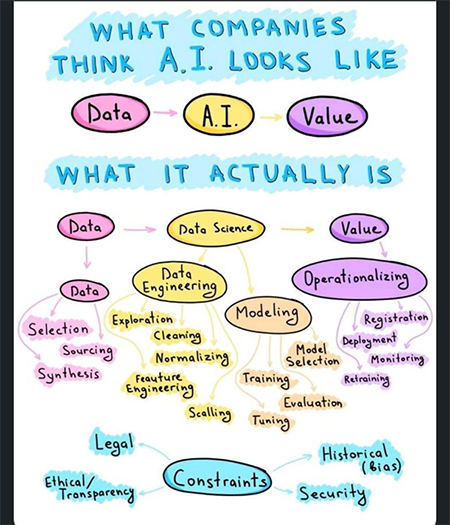
Effective management relies on the correct and timely application of knowledge to prevent errors, fix mistakes, and seize opportunities. Obtaining said knowledge requires a lifetime of experience and constant updates to an ever-increasing flow of information. While the human brain processes an impressive amount of data, computers—with their dedicated processes and generationally refined materials—do even more, even faster.
Of course, processing power is only one piece of the puzzle. Absent the ability to turn raw data of metrics into the precise function of key indicators, a computer is nothing more than a box talking to itself.
Big Innovations of Big Data
With big data comes big hype. It’s important to remember that data alone does nothing. What we need from data are pearls of wisdom—usable and actionable—combining global payroll data and information from finance, benefits, and recruitment. Payroll professionals can help the business analyze payroll trends used by executive leadership for better decision-making and organizational expansion. Fortunately, the computers that brought the problem can help with the solution.
The problem lies in how and where data is captured. We know the times of day applicants apply, the average length of their cover letters, and the keywords they most often use. This information does little on its own, but with the help of computers, we can process and categorize this data into usable metrics.
From this pivot point, you can start to pose questions like, “What is the peak time for applications?” You can also take this a step further and chart it against hires to ask, “What time do applicants hired by the company apply?”
Now you are looking at a key performance indicator (KPI). When you realize the type of applicants who often apply at certain times of day are the ones who get hired, you will know something valuable about when people submit their best work.
Groundhog Day at a Glance
In a sense, this is information you, as a global payroll manger or HR manager, already know intuitively. Experience and instinct blend to provide these rare and nearly intangible insights. Proper analytics through data science provides a tangible manifestation of this intuition.
Imagine if you could follow every employee from start to finish in the hiring process and then reset back to the moment before that person was hired. Much like Bill Murray’s character in the 1993 film “Groundhog Day,” eventually you would know enough about every applicant and always make the best decisions.
These decisions would not be a guess or an instinct. It would be decisions you could make with assurance because you have witnessed the scenario hundreds of times. This is exactly what analytics brings to the table. Why live each hire over and over when all those theoretical days already exist in the data?
Benchmarking, Insights
Analytics produce information relevant to actionable areas. To properly use this data, you need clear goals, including HR analytics, people analytics, financial metrics, and data heuristics.
HR analytics and financial metrics seek to answer questions about the immediate needs of a business. They often look for a short, straight line between a company’s need and its bottom line. The predictive and strategic analytics formed here often lack nuance but generate insight through one-to-one comparisons.
People analytics look outside a business to encompass customers, suppliers, and non-customers. These metrics focus on those who want support or reject your offerings. Each provides insight into the other, providing targeted and real bottom lines for your analytics.
Data heuristics represents the feedback loop at the end of any analytic process. The more frequently data produces a KPI, the better the data. Regardless of the result, adjusting and re-feeding the data leads to better results and more robust data.
Keep in mind that analytics are not a one-size-fits-all solution. You want to refine your questions to a specific organization or process to avoid getting promising results that apply to unreal scenarios.
Drawbacks in the Machine
Currently, trends in artificial intelligence (AI) and machine learning (ML) show exactly how tenuous a computer’s grasp of basic information can be. While the system improves itself over successive iterations, the iterative processes—not self-correction—are what bring about improvement. It’s all about asking the right questions.
The Why
The most important element of data analytics is knowing “the why.” Data science and analytics unquestionably help payroll, HR, and finance to see the larger picture. The tools are powerful but require guidance to produce effective results for a business.
Ask yourself this question: What are you trying to solve? Your payroll data could reveal compensation is growing in one region while revenues or profits are dropping. It could reveal that key leadership roles in an area are due to retire soon, which means you may need to activate your succession planning.
Collecting robust raw data, filtering it through vetted metrics, and arriving at key indicators is what data science has always been about. The difference in the new world of data science is the size of the data and the accuracy of the results, but only if you ask the right questions.
The right questions do not come factory standard. One can think of it as working backwards. Know your “why” before asking your question. Don’t just need data, know why you need it.